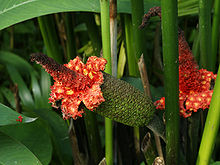Carludovica palmata
| Panama hat plant | |
|---|---|

| |
| Scientific classification | |
| Kingdom: | Plantae |
| Clade: | Tracheophytes |
| Clade: | Angiosperms |
| Clade: | Monocots |
| Order: | Pandanales |
| Family: | Cyclanthaceae |
| Genus: | Carludovica |
| Species: | C. palmata
|
| Binomial name | |
| Carludovica palmata Ruiz & Pav. (1798)
| |
| Synonyms[1] | |
Carludovica palmata (Panama hat plant or toquilla palm) is a palm-like monocot plant. It is not a true palm. Its leaves are different from the leaves of true palms, and unlike true palms it does not develop a woody trunk. Its female flowers (which mature first) have large stigmas, and its male flowers (which mature later) have a lot of pollen.
The Panama hat palm is cultivated from Central America to Bolivia. Its soft, flexible, and durable fibers are used to weave Panama hats[2] and other items.
References[]
- ^ Tropicos, Missouri Botanical Garden
- ^ Johnny Morris (8 June 2007). "Crowning glory of the Andes". The Telegraph. Retrieved 24 September 2010.

Fruit

Carludovica palmata by J. van Aken, 1860-1870
| Wikimedia Commons has media related to Carludovica palmata. |
Categories:
- Cyclanthaceae
- Flora of Central America
- Flora of South America
- Plants described in 1798